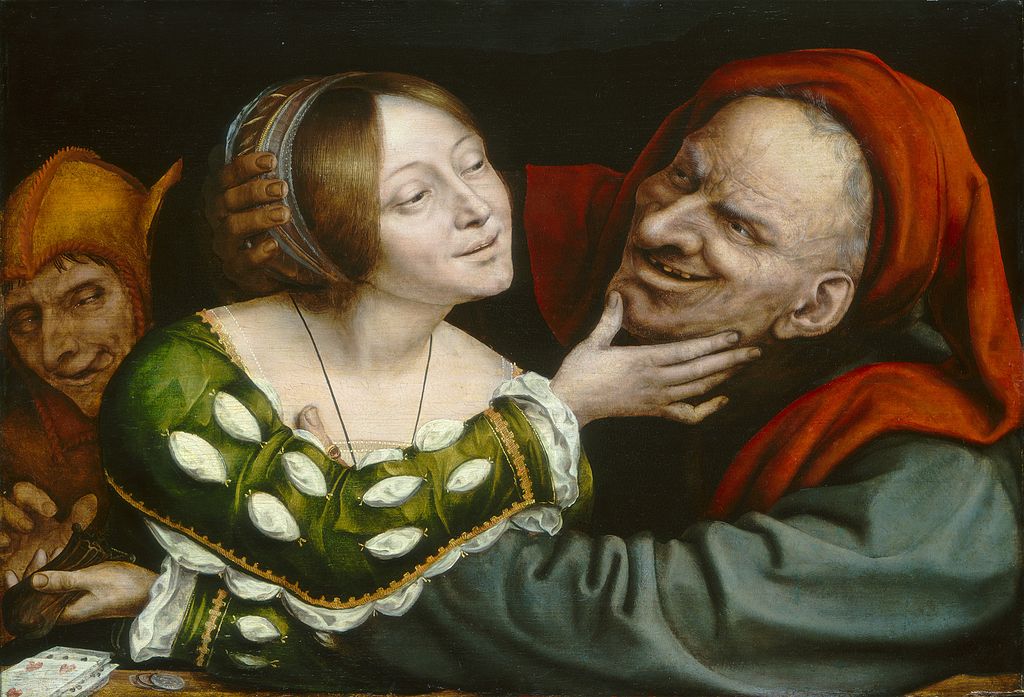Books & Culture
A History of the Wench
How a medieval word meaning "servant" or "child" evolved to become a racist slur

In 2010, Dolen Perkins-Valdez published the best-selling historical fiction novel Wench. According to the back cover, the novel’s setting is “an idyllic retreat for Southern white men who vacation there every summer with their enslaved black mistresses.” The book’s front matter includes a quotation from 1836 about a slave owner who “especially prided himself upon owning the swiftest horse, the handsomest wench, and the finest pack of hounds in all Virginia.”
This title caught my eye for a few reasons. First, the story has particular personal resonance for me: My great-great-great grandmother was an enslaved cook on a plantation in east Texas. Her master, who owned the plantation, raped her. She gave birth to my great-great grandmother as a result. I do not know my great-great-great-grandmother’s name, but I think about her, sometimes, when I’m making dinner.
What was this Middle English term doing in a novel about the sexual exploitation of enslaved black women?
But second, I am a medieval scholar who was, at the time, in the midst of researching the term wench’s sexualized associations in the Middle Ages. What was this Middle English term, “wench,” doing in a novel about the widespread sexual exploitation of enslaved black women in the United States?
As it turns out, the term’s medieval history paved the way for its later use as a gendered racial slur, evolving from a relatively neutral term designating youth or servitude to one signifying femininity, then transgressive feminine sexuality, and finally black feminine sexuality. This long history enabled “wench” to become a tool for dehumanizing black women, insisting on their sexual availability to white men, and facilitating their exploitation.
“Wench” has its earliest roots in the Old and early Middle English “wenc(h)el,” which designated a servant or slave of any gender, or a child. (A text from around 1200 refers to “An wennchell thatt iss iesu crist,” a child that is Jesus Christ.) In 890, the Old English noun “wencel” translates the Latin “mancipium,” which means “possession, property, servant, slave.” Wencel is a term designating subordinate status and a lack of power, but during this time period, that disempowered status was tied to youth and servitude rather than femininity or sexuality.
This changed in the later Middle Ages as “wench” became both gendered and sexualized. It signified (per the Middle English Dictionary), “a girl” or “young woman;–occasionally with disparaging overtones,” “a serving maid, bondwoman,” and “a concubine, paramour, mistress; a strumpet, harlot.” This multivalence, with its underlying connotations of youth, femininity, lower social status, servitude, and sexual transgression, invokes multiple grounds of disadvantage. The “wenche” is subservient to higher-ranked women—“ladies”—as well as to all men, and she is marked by the stain of illicit sexuality. The Book of Vices and Virtues, a comprehensive guide to recognizing the seven deadly sins, forbids complaining by “wenches ayens here ladies” [wenches against their ladies], setting up a relationship of inequality and subservience between “wenches” and “ladies.” When her jealous husband suspects her of adultery, the character May in Geoffrey Chaucer’s Merchant’s Tale insists, “I am a gentil womman and no wenche.” She sets up a stark class differential between the “gentil womman” on one hand and the “wenche” on the other, portraying the latter term as derogatory and linking it to sexual transgression. According to May, only “wenches” cheat on their husbands. William Langland’s Piers Plowman mentions “wenches of the stewes” [whores from the brothels] at multiple points. Bible translator John Wyclif uses “wenche” derisively six times, in addition to “strumpet” and “yong strumpet,” to name the dancing Salome in a sermon about the beheading of John the Baptist, setting up “wenche” and “strumpet” as synonyms. The female speaker of an erotic song recalls her early sexual experiences “when I was a wanton wench / Of twelve yere of age,” underscoring the term’s popular links to wantonness. Finally, in King Ponthus and the Fair Sidone, Guenelet uses the term after becoming angry when Sidone rejects his advances: “he thretened her sore and swore that he sholde take her by force and make her his wenche yf she wolde not be his wyfe.” Here, “wenche” functions in opposition to “wyfe” and is part of Guenelot’s threat to overpower and rape Sidone “by force.”
The implications of “wench” are most chilling in Chaucer’s Reeve’s Tale, which tells the story of two Cambridge students who spend the night at a miller’s house after the miller steals some of their grain. The miller has a 20-year-old daughter named Malyne. The tale introduces Malyne as a “wenche,” following the term with a sexualized description of her body: “This wenche thikke and wel ygrowen was…With buttokes brode and brestes rounde and hye” [This wench was thick and well-developed…With broad buttocks and round, high breasts]. Here the term “wenche” invites us to leer at Malyne, focusing on the shape of her buttocks and breasts. It guides audiences to view her as a gendered, lower-status, dehumanized body created as an object for others’ gratification. That night, the miller’s family and the two students enjoy a boozy dinner. The miller, his wife, and Malyne pass out afterward, and their drunken snoring keeps the students awake. “The wenche rowteth eek” [The wench snores too], we are told, the term here serving to emphasize Malyne’s unladylike snoring as well as the intoxication that causes it. As the two students lie awake in bed fuming over the miller’s theft of their grain, Aleyn crudely declares to John, “yon wenche wil I swyve” [I will fuck that wench]. Here, the term works to dehumanize Malyne and to position her as an acceptable target for assault. Finally, “wenche” is used two times in two lines to name Malyne just before Aleyn rapes her: “And up he rist, and by the wenche he crepte. / This wenche lay uprighte and faste slepte” [And up he rose, and by the wench he crept. / This wench lay flat on her back and fast slept.] By naming Malyne as “wenche” in these moments just before her rape, the text discourages empathy for her plight and sets her up as both naturally subordinate and as sexually available, the term working both to mark her as exploitable and to downplay her rape. In the Reeve’s Tale, the term “wenche” illustrates how Malyne is vulnerable to the students’ predatory actions due to her social status, gender, and age, while its sexual associations are insidiously marshaled to make her seem as though she is “asking for it,” to allow her rape to be read as not-rape.
The fact that the term already designated age, gender, subordinate social status, and sexual availability meant that it was ready-made for race to be mapped onto those other inequalities.
Three centuries later, the term “wench” proliferated in newspapers on the other side of the Atlantic. By now, in addition to connoting gender, social status, sexual availability, and age, it had become racialized to designate an enslaved black woman. In 1828, Noah Webster’s American Dictionary of the English Language defined “wench” as “In America, a black or colored female servant; a negress.” John Russell Bartlett’s 1848 Dictionary of Americanisms contains the entry, “WENCH. In the United States, this word is only applied to black females.” The fact that the term already designated age, gender, subordinate social status, and sexual availability meant that it was ready-made for race to be mapped onto those other inequalities so that it could function as a pejorative term for black women that disparaged them and advertised their sexual availability to white men. Once again, the term’s derogatory connotations work to overshadow the very real and constant violence that black women suffered as a result of their intersecting disadvantages. When a woman is called a wench, we are prepped by centuries of connotation to see her as something intended for sexual use.
The phrase “Negro wench” appears repeatedly in slave advertisements and runaway slave reward posters from the eighteenth and nineteenth centuries. A 1735 issue of the Pennsylvania Gazette advertised “A likely young Negro Wench, who is a good Cook and can wash well, to be disposed of,” while a 1749 issue proclaimed, “To be SOLD, TO be sold cheap, a very likely young Negro wench, about 18 years of age: Also fine Palm oyl, by the half dozen pound, or lesser quantity.” This linking of the “cheap…Negro wench” with the “fine Palm oyl” emphasizes her status as a commodity to be sold. In these advertisements, the adjective “likely” means “good-looking” or “attractive” as well as “capable, vigorous, strong,” and almost always appears alongside “wench” as a rhetorical convention. In 1766, Pennsylvania botanist and explorer John Bartram wrote in a letter, “I have sent thee six likely young negroes amongst which is two young breeding wenches.” Bartram emphasizes the enslaved women’s age, race, gender, and sexuality, using the term “wench” to dehumanize them as reproductive commodities. In an interview about Wench, Dolen Perkins-Valdez discussed her choice to use the term as her novel’s title: “I felt that given the sexual servitude of my female characters, this word would most accurately evoke the set of cultural expectations they were tangled within,” she said. The novel features a reward poster for a runaway enslaved woman stating, “$100 REWARD for NI**ER WENCH.” This echoes historical posters such as the 1810 one proclaiming, “Runaway Wench. Absconded from Georgetown, Columbia…a mulatto wench named Lottie.”
In 1913, Julian Shakespeare Carr—a wealthy North Carolina white supremacist, Confederate war veteran, and outspoken Ku Klux Klan supporter who once referred to a massacre of 60 black citizens in Wilmington as “a grand and glorious event”—dedicated the Confederate soldier monument statue known as “Silent Sam” on the University of North Carolina-Chapel Hill’s campus. In his dedication speech, Carr shared a personal anecdote. He said,
One hundred yards from where we stand, less than ninety days perhaps after my return from Appomattox, I horse-whipped a negro wench until her skirts hung in shreds, because upon the streets of this quiet village she had publicly insulted and maligned a Southern lady, and then rushed for protection to these University buildings where was stationed a garrison of 100 Federal soldiers. I performed the pleasing duty in the immediate presence of the entire garrison…
Carr brags of brutally whipping a black woman seeking protection, calling his violent act a “pleasing duty” that he performs publicly for a group of one hundred men. Here, as in medieval texts, the “negro wench” is deliberately contrasted with the “Southern lady,” setting up a stark status differential. He uses the term “wench” to racialize and dehumanize the woman whom he attacks and to downplay his violence against her, illuminating the term’s cultural currency.
On February 12 of this year, antiracist activists in Chapel Hill erected a plaque dedicated to the woman. It read, “In honor of the Negro Wench. She ran to this University for safety and, for the color of her skin, was beaten at its gates. We fight in her name.” Three days later, the plaque was stolen. A video celebrating the theft was posted to Confederate 901’s Facebook page, titled “Antifa lost their first monument at Chapel Hill.” The plaque was reinstated on February 20, then broken and partially stolen before its pedestal and remaining portion were removed by town officials two days later due to “public safety concerns.”
When I did a Google image search looking for newspaper advertisements featuring the phrase “Negro wench,” something else came up as well. It was a still from a porn video someone had posted to YouTube, titled “Negro bed wench.” In the still, a naked white man is positioned behind a young black woman on a bed. With one hand, he holds her hair tightly. With the other, he digs his fingers into her mouth and pulls out her lips and cheeks. Her eyes are wide, her mouth yanked into a painful-looking grimace. Like Malyne’s rape in Chaucer’s Reeve’s Tale, this scene of racialized sexual violence illuminates how “wench” can operate: by bundling together different kinds of disempowerment and rendering its object always already sexually available, the term simultaneously makes “wenches” more vulnerable to violence and glosses over that violence by portraying them as “asking for it.”
The video’s title is also the name of a popular pornographic trope in which sexual violence by white men against black women is racialized and eroticized. It is meant to arouse desire, to get people off. In her study of black women in pornography, Mirielle Miller-Young analyzes how black women performers in early pornographic stag films from the 1930s, 40s, and 50s “often played sexually passive domestic servants in interracial encounters with white men.” She notes that “coercive sex, and the woman’s performed resistance, is part of the fantasy” that this trope entails.
The medieval paved the way for the later dehumanization and exploitation of black women.
It is imperative to understand this term’s medieval English and American racialized histories in order to grasp how the medieval, in this case, paved the way for the later dehumanization and exploitation of black women. The term initially designated age and social status in the early Middle Ages, then became gendered and sexualized in the later Middle Ages, functioning as a term of intersectional disadvantage. Once the Atlantic slave trade commenced, race was able to be seamlessly mapped onto “wench”’s web of preexisting associations with inequalities—gender, class, age, sexual availability—so that it came to signify a young enslaved black woman, its medieval pejorative sexual connotations enabling the “wench” to be viewed as hypersexualized and accessible to white men.
This is one of the many reasons why the medieval matters. It is the Middle Age’s derogatory linguistic freight that allowed this term to become a tool of misogynoir, a term coined by Moya Bailey and Trudy to name “the ways that anti-Blackness and misogyny combine to malign Black women in our world.” We are still reckoning with these attitudes today, as illustrated by the 6-part Lifetime documentary Surviving R. Kelly, which aired in January and detailed R&B singer R. Kelly’s decades-long sexual exploitation of black girls. This documentary starkly illustrated how our culture’s long history of viewing young, economically disadvantaged women as sexually available—specifically narrowing to black women in the eighteenth century—has devastating effects on those women. It just as clearly illuminated how our culture’s linking of these qualities together allows violence and abuse to go unrecognized and unaddressed. As writer Mikki Kendall states near the end of the documentary, “We still, socially, don’t perceive black women as innocent.” The history of the term “wench” can show us how those attitudes developed. And it is my hope that, armed with the knowledge of how those attitudes accrued and calcified until we took them for granted, we can begin to chisel away at them.








